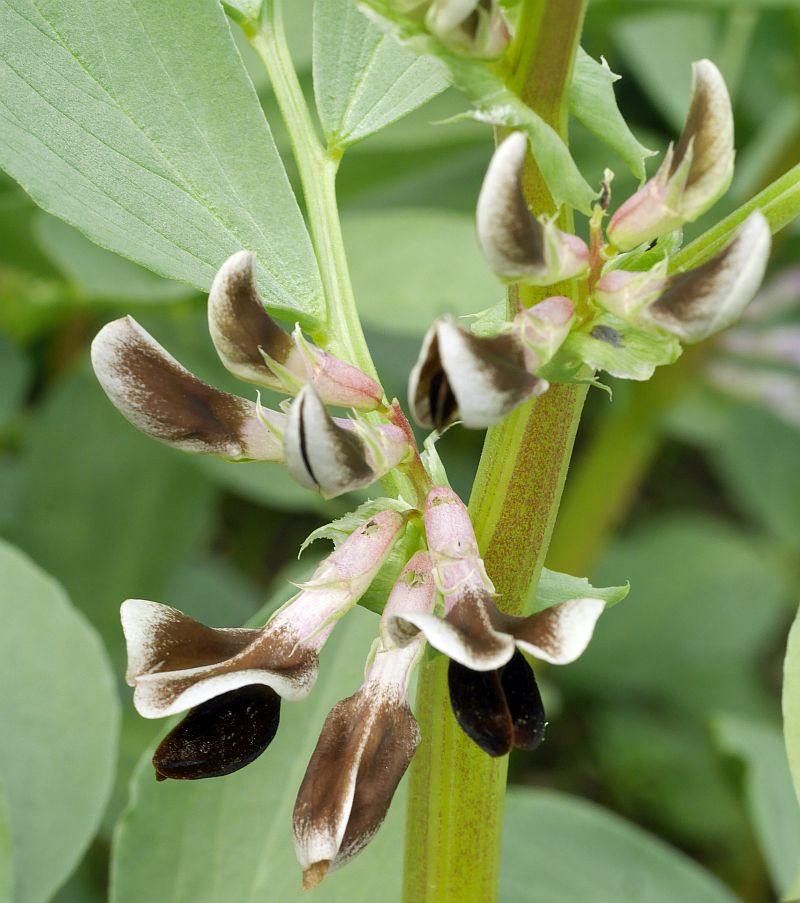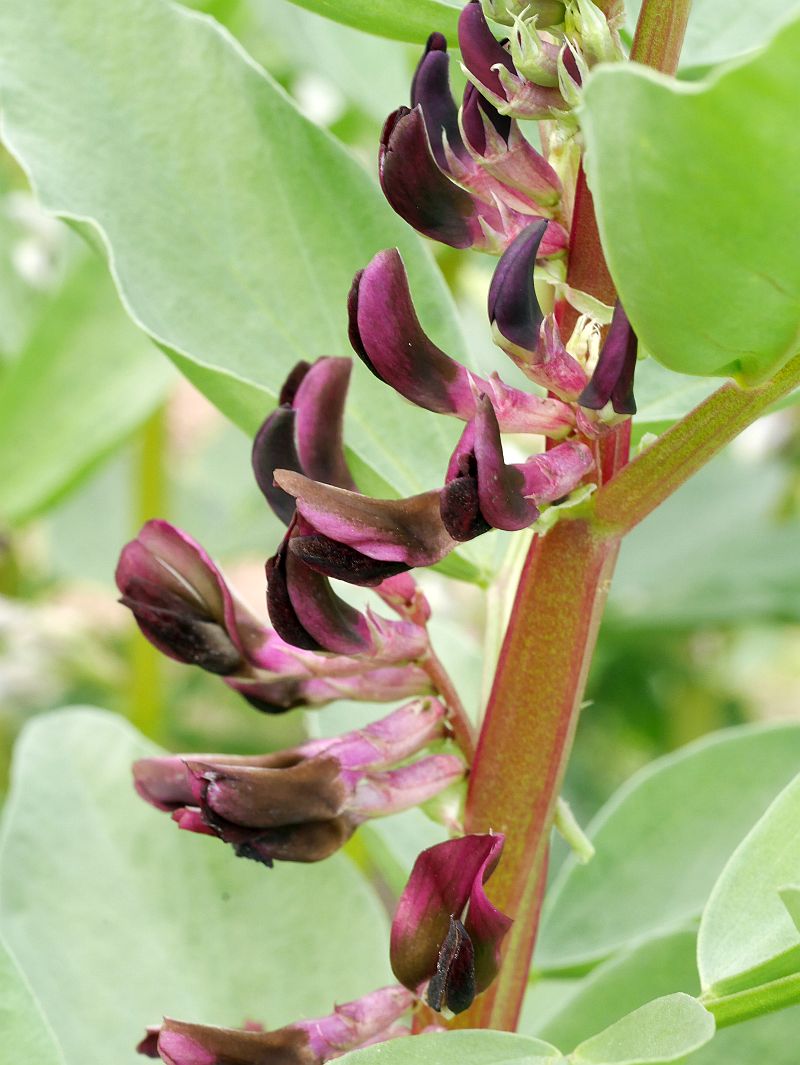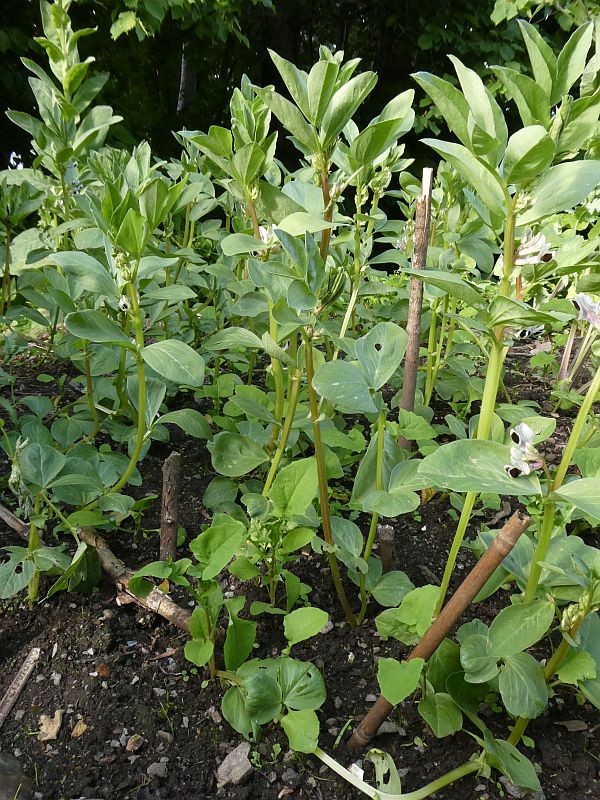Yesterday was St. John’s Eve and many Norwegians (and other Scandinavians) celebrated what is known here as Sankthans or Jonsok with communal bonfires, the big midsummer celebration. Sankt Hans is a short form of Sankt Johannes. There is a special perennial onion which was traditionally harvested on this day in the Netherlands, which I believe to have a much large potential than its current status as a local food crop, as it is so much easier to grow, in particular in areas increasingly suffering from summer droughts and water shortages and avoids common pests of onions and shallots by its early growth and perhaps also resistance. If nothing else, it complements shallots and onions in that it is available much earlier in the year!
There is genetic evidence that St. John’s onion (Johannes-løk) has a unique triparental origin A. × cornutum with three putative parental species, A. cepa, A. pskemense, and A. roylei. Hardiness is probably bestowed by hardy Allium pskemense which has been growing in the Ringve Botanical Gardens in Trondheim for many years. A similar hybrid has been found both in Germany, Croatia and India. It was perhaps more widely cultivated in the past and these are just remnant populations. On 21st June I harvested the Croatian accession from the Onion Garden Chicago at the Ringve Botanical garden which had been left for two years resulting in hundreds of tightly packed onions and on 22nd June from the World Garden at the Væres Venner Community Garden. I replanted in both gardens single bulbs separated by about 10cm. in a roughly circular patch.
Last night, St. John’s Eve, I started a vegetarian midsummer tradition by making St. John’s Felafels with dried broad beans stored since the autumn and golpar spice (from dried seeds of a mix of Heracleum sp.).
See more about Johannes’ shallot at https://www.edimentals.com/blog/?p=22601





Tag Archives: Broad beans
Green pasta
This is what I had for dinner last night: a Mediterranean-diet style green (wholegrain spelt) pasta dish with wild fungi, annual greens, broad beans, weeds, golpar, chili and epazote (see more on the ingredients used under the picture!).

My daughter, Hazel, peeling away the inedible slime layer of slimy spike-cap (sleipsopp):
We used two mild tasting Russula species (kremler):
 Broad beans (bondebønner) and swiss chard (mangold)
Broad beans (bondebønner) and swiss chard (mangold) 

 Shallots (Finnish heritage variety) which were harvested in September 2022 are still looking good:
Shallots (Finnish heritage variety) which were harvested in September 2022 are still looking good: Sonchus oleraceus (common sow-thistle / haredylle), probably my most used veg at this time of year, even though most consider it a weed! WEEDS ARE TO FEED!
Sonchus oleraceus (common sow-thistle / haredylle), probably my most used veg at this time of year, even though most consider it a weed! WEEDS ARE TO FEED!

Epazote, wormseed / sitronmelde (Chenopodium ambrosioides), leaves from an 11-year old plant which is overwintered indoors in a cold room down to 3-4C:
 Even the guest bed is in use for drying seed! Here is the 2023 crop of golpar (Heracleum spp.) seed :) :
Even the guest bed is in use for drying seed! Here is the 2023 crop of golpar (Heracleum spp.) seed :) : Otherwise, we used courgette, nettle, chili and Hitra Blue organic cheese!
Otherwise, we used courgette, nettle, chili and Hitra Blue organic cheese!
50 and 20 year celebrations
To celebrate our good friends’ Jurgen Wegter and Ingvild Haga’s 50th birthdays together with Meg’s 50-year anniversary of arriving in Europe for the first time (in Southampton near where I lived at the time) as well as my 50 year anniversary of leaving school and a memorable holiday with 20-30 school friends in Newton Ferrers in Devon, we made a special gourmet dinner of green mac-cheese. It had masses of veg mixed in – the year’s first broad beans and swiss chard, chicory, common sow thistle (Sonchus oleraceus), Allium senescens leaves, shallots and garlic from last year, rehydrated winter chantarelles, golpar – ground seed of hogweed – Heracleum spp., together with ramsons salt, chili, sun dried tomatoes and mustard, all in a wholegrain spelt white sauce with wholegrain spelt pasta; it was topped with alpine bistort bulbils).
Not to be left out, the Extreme Salad Man contributed one of his Meditteranean diet inspired multispecies salads commemorating it is now almost 20 years since he put together a salad from home grown ingredients in Malvik comprising 537 ingredients. something the world hasn’t seen before or since (see https://www.edimentals.com/blog/?p=18997). The record was set on 24th August 2003. This time there were a mere 106 ingredients….sad to see, but he must be losing it….
Thanks to Jurgen for the salad pictures: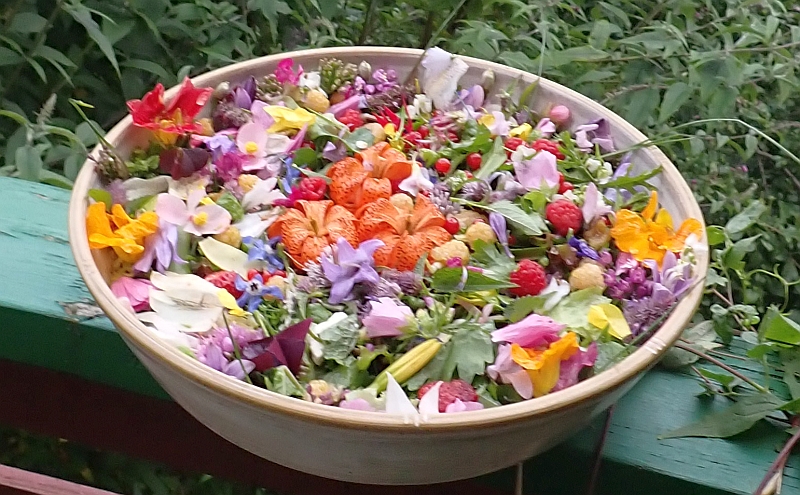


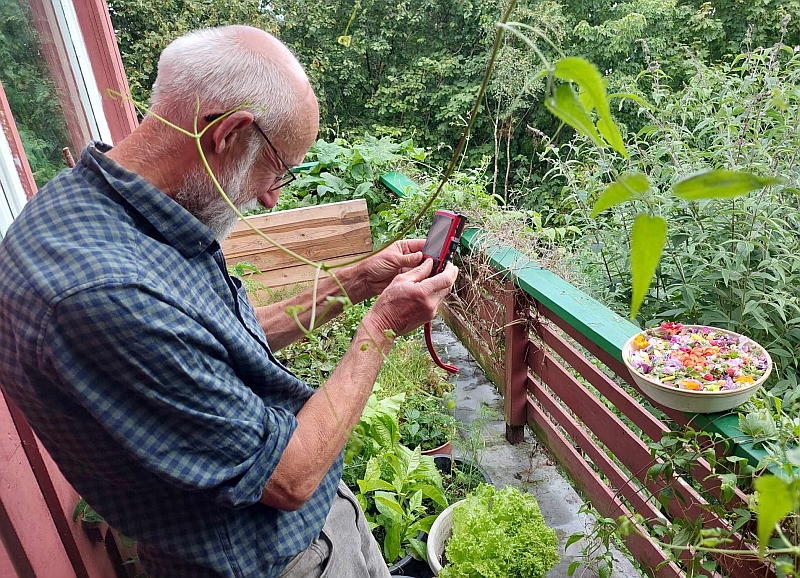

Red Cheeks and Fingerprints
I harvested two of the more beautiful broad (fava) beans I’ve grown yesterday, both of which originate in Canada. Red Cheek and Fingerprint favas. The diversity of forms, colours and sizes in these beans doesn’t cease to amaze me! I will definitely be trying to maintain these forms within my grex of broad beans (selection for a wide diversity of different forms every year and all planted close together so that they will cross promiscuously)!
Read legendary Will Bonsall’s article on fava beans where he talks about the diversity of forms and his collection of 250 varieties he maintains for Seed Savers Exchange: https://www.mofga.org/resources/beans/favas

Broad Bean Diversity contributes to Resilience
Broad beans (favas / bondebønner) will easily cross with other varieties that are growing nearby. In order to keep a variety pure, you need to isolate them physically. I’ve chosen a different strategy and manage to maintain a mix of different bean colour and size forms by selecting for these characteristics every autumn. This automatically gives different flower colours too (broad beans are beautiful enough to be included in the edimental category and are also edi-ento-mentals as they are also extremely popular with bumblebees). Here are my selections which I made yesterday after drying the beans for storage. 
Each form will be stored separately and each variety will be planted close to each other in a large block of beans containing many different forms! I think that diversity within a species also contributes to a good harvest with better bean set. I have never had a crop failure using my own home saved mix of beans. I don’t offer the different forms as named varieties, but as a mix or composite “Væres Venner* Mix” through the KVANN / Norwegian Seed Savers yearbook (kvann.no) in February so that others can also select for separate forms!
*Væres Venner is the community garden where most are grown.
See also this post showing the diversity of flowers that produced these beans: https://www.edimentals.com/blog/?p=26183
Broad Bean Mix
Broad beans (favas / bondebønner) will easily cross with other varieties that are growing nearby. In order to keep a variety pure, you need to isolate them physically. I like to have different varieties with different coloured flowers and bean colour in additon to maintaining early yielding varieties such as Express. I’ve found that I can plant different forms close together and if I save separately beans with different colour and bean size and mark for saving plants with particularly nice flower colours, then I can maintain a good mix in the same place. The flower forms below are all growing within a few metres in the Væres Venner community garden. They were grown from the mix of beans saved at the same place in 2018 (first picture). I don’t offer the different forms as named varieties, but as a mix or composite “Væres Venner Mix” so that others can also select for separate forms! Bumble bees were all over the flowers when I was there!
No thanks no dig
Before I go any further, I should say that 2/3 of my cultivated area is almost 100% no dig (perennials is the ultimate no dig) as I grow perennial vegetables, fruit, berries and nuts. I rarely dig in these areas at all as I only plant once and don’t disturb the plants for years. I do still grow annuals on my raised beds…beds which are about 1.2m wide and are never walked on. I add compost on most of the beds each spring and lightly dig over to incorporate the compost and, surprising to most folks, to encourage the weeds to germinate.
There’s one weed in particular that I’m encouraging, Sonchus oleraceus (common sow thistle / haredylle). As I’ve written before (also in the 12 page essay in my book on the sow thistles), this is my favourite summer leafy green vegetable which I eat most days from July to September. It grows quickly and is actually more nutritious than standard greens. It’s also rich in antioxidants and I love it’s slightly bitter taste which goes well with pretty well any dish I might prepare, always mixed with other “vegetables of the day”. We ate it tonight in a pea soup and, yesterday, in a green pasta sauce and the day before that in pizza…
Yesterday, I weeded my second crop broad beans which were growing in a sea of “weeds” and as I weed I selectively allow the sow thistle to grow on between the beans and on the edge of the bed (you can think of this as “WEEDING YOUR WEEDS”). The video and pictures show the broad beans with the young self-seeded sow thistle plants in between. These will grow up quickly in the next 2-3 weeks and I harvest just before they start flowering. This doesn’t interfere with the growth of the broad beans which take much longer to mature to harvest. Later on, the next wave of sow thistle will be allowed to grow on the edges of all the beds where it doesn’t interfere with the main crops, a method used by the Maori of New Zealand which inspired me to introduce Sonchus oleraceus to my garden. Eating your weeds can significantly increase your yield. I must admit that I love weeding, a quiet time in the garden observing wildlife around me…….similarly, I love washing up, both quiet times contemplating. There’s even a name for weeds that are cropped…it’s a cryptocrop. Cryptocropping has been practised by many other peoples around the world.
Any nutrients or soil which might be washed out from my annual beds during periods with naked soil ultimately end up in my forest garden and perennial plantings below, so are not lost! However, there isn’t much loss as my soil is high in humus after over 35 years adding compost!
I’ve tried no dig in the past, but I would need a much bigger area to produce sufficient material for mulching and I also found that in my shady cool garden the soil heated up much too slowly and slugs were also a bigger problem.
In the video, I zoom into the low growing young sow thistle plants between the taller broad bean plants:
Broad beans, falafels, new potatoes and golpar


I also harvested the first potatoes at home…and the year’s first falafels resulted with new potatoes for dinner. The falafels were flavoured with salt, pepper, shallots, chili and golpar (ground seed of any species of Heracleum or hogweed) which gives a delicious exotic flavour!

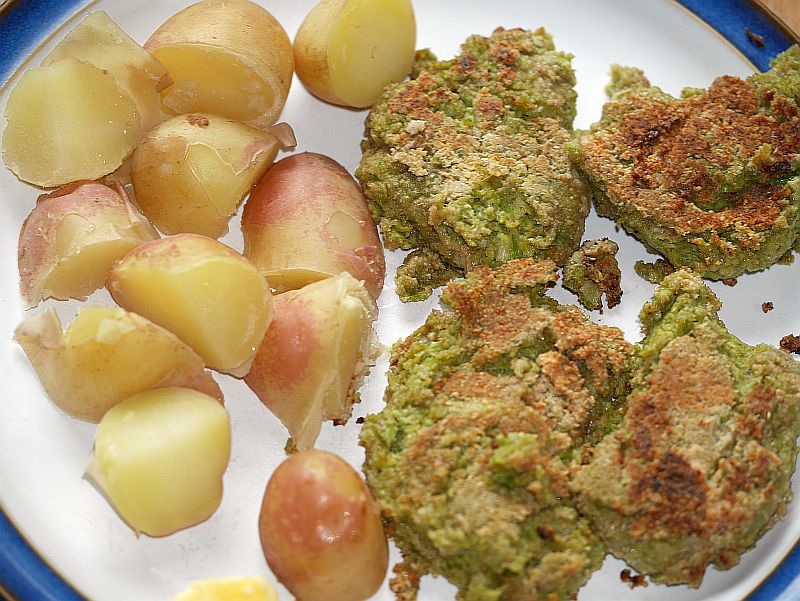
Heracleum sibiricum gives the local variant of golpar here…most people have a local variety of hogweed to harvest, even Giant Hogweed (Heracleum mantegazzianum) or Tromso palm (H. persicum), the latter giving the most authentic Iranian golpar spice.


Veggie wholegrain pizza with New Zealand Spinach
We ate at home!
Væres Venner Community Garden 29th August 2018
See the video:

